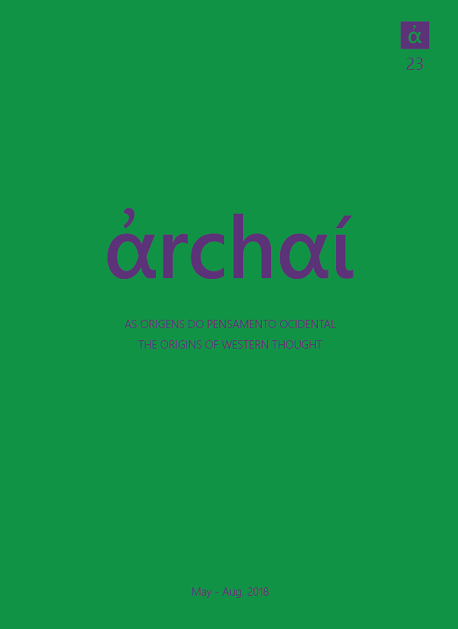The image of kinaidos in Plato’s Gorgias
DOI:
https://doi.org/10.14195/1984-249X_23_3Keywords:
Plato, Gorgias, kinaidos, hedonism, Greek homosexualityAbstract
In the final part of Plato’s Gorgias, Socrates uses an example in order to shame Callicles and thereby confront his hedonistic position. The term kinaidos can embarrass translators, interpreters and contemporary readers of the dialogue - some Brazilian editions use translations such as “devasso” and even “veado”. Socrates suggests that if we accept the identification between good and pleasure we should admit the life of the kinaidos as a happy one. But what exactly is the life of the kinaidos? Why cannot it be an example of a happy life? Although this image is abandoned quickly, this socratic argumentative device is decisive for the development of the discussion in the Gorgias. So until these questions are adequately answered, Socrates’ argument will remain partially unintelligible.
I start this article trying to demonstrate the importance of the kinaidos as the culminating example in an imagetic refutative process initiated by Socrates. Then I analyze the state of the question and demonstrate why studies of the level of importance of Charles Kahn, Kenneth Dover and John Winkler have not been able to cover all aspects of the meaning of this specific image in the Gorgias. Finally, I try to propose an interpretation according to which the mention of the kinaidos would be a Platonic response to a greek anti-intellectualist thesis, like the one present in Euripides’ Antiope. This response has a crucial role in Plato’s project to legitimize and specify philosophy against the practice of rhetoric.
Downloads
References
DODDS, E. R. (1990). Plato - Gorgias. A Revised Text with Introduction and Commentary. Oxford, Clarendon Press.
DOVER. K. J. (2007). A homossexualidade na Grécia Antiga (trad. Luís Sérgio Krausz). São Paulo, Editora Nova Alexandria.
COLLARD, C. CROPP, M. (ed.; trad.). (2008). Euripides 480-406 a. C: Fragments. Cambridge, Harvard University Press.
FOX, M. (1998). The constrained man. In: Foxhall, L., SALMON, J. Thinking Men: Masculinity and its Self-Representation in the Classical Tradition. London and New York, Routledge.
GUTHRIE, W. K. C. (1975). A History of Greek Philosophy. (vol. IV) Cambridge, Cambridge University Press.
HALPERIN, D. M. (2008). Platonic Eros and What Men Call Love. Ancient Philosophy 5 (2), p. 161-204.
HALPERIN, D. M. (1988). Forgetting Foucault: Acts, Identities, and the History of Sexuality, Representations, No. 63 (Summer, 1998), p. 93-120.
HALPERIN, D. M. (1986). Plato and Erotic Reciprocity. Classical Antiquity 5, p. 60-80.
HALPERIN, D. M.; WINKLER, J. J., ZEITLIN, F. I. (1990). Before sexuality: The construction of erotic experience in the ancient Greek world. Princeton, Princeton University Press.
IRWIN, T. (1995). Plato. Gorgias. Oxford, Clarendon Press.
KAHN, C. H. (1983). Drama and Dialetic in Plato’s Gorgias. Oxford Studies in Ancient Philosophy 1, p. 75-121.
KLOSKO, G. (1984). The refutation of Callicles in Plato’s Gorgias. Greece and Rome (Second Series), 31.02 (1984), p. 126-139.
LEVY, D. (2014). Socrates vs. Callicles: Examination & Ridicule in Plato’s Gorgias. PLATO JOURNAL: The Journal of the International Plato Society 13, p. 27-36.
LOPES, D. R. N. (2011). Górgias de Platão. Tradução, ensaio introdutório e notas. São Paulo, Perspectiva.
MCKIM, R. (1988). Shame and Truth in Plato’s Gorgias. In: Griswold, C. Platonic Writings / Platonic Readings. New York, Routledge.
MOSS, J. (2005). Shame, Pleasure and the Divided Soul. Oxford Studies in Ancient Philosophy. Oxford, Carendon.
NIGHTINGALE, A. (1995). Genres in Dialogue: Plato and the Construct of Philosophy. New York, Cambridge University Press.
PARRY, R. D. (2014). Psychological Dimensions of Elenchus in the Gorgias. Archai, n. 14, Jan - Jun, p. 65-76.
PINHEIRO, A. E. (trad.; notas). (2009). Xenofonte, Memoráveis. São Paulo, Annablume Clássica.
SNELL, B. (1964). Vita Activa and Vita Contemplativa in Euripides’ Antiope. Scenes from Greek Drama, p. 70-98.
TARRANT, H. (2008). The Dramatic Background of the Arguments with Callicles, Euripides’ Antiope, and an Athenian Anti-Intellectual Argument. Antichthon 42, p. 20-39.
WINKLER, J. (1990). The Constraints of Desire. The Anthropology of Sex and Gender in Ancient Greece. New York & London, Routledge.
Downloads
Published
How to Cite
Issue
Section
License
Given the public access policy of the journal, the use of the published texts is free, with the obligation of recognizing the original authorship and the first publication in this journal. The authors of the published contributions are entirely and exclusively responsible for their contents.
1. The authors authorize the publication of the article in this journal.
2. The authors guarantee that the contribution is original, and take full responsibility for its content in case of impugnation by third parties.
3. The authors guarantee that the contribution is not under evaluation in another journal.
4. The authors keep the copyright and convey to the journal the right of first publication, the work being licensed under a Creative Commons Attribution License-BY.
5. The authors are allowed and stimulated to publicize and distribute their work on-line after the publication in the journal.
6. The authors of the approved works authorize the journal to distribute their content, after publication, for reproduction in content indexes, virtual libraries and similars.
7. The editors reserve the right to make adjustments to the text and to adequate the article to the editorial rules of the journal.



